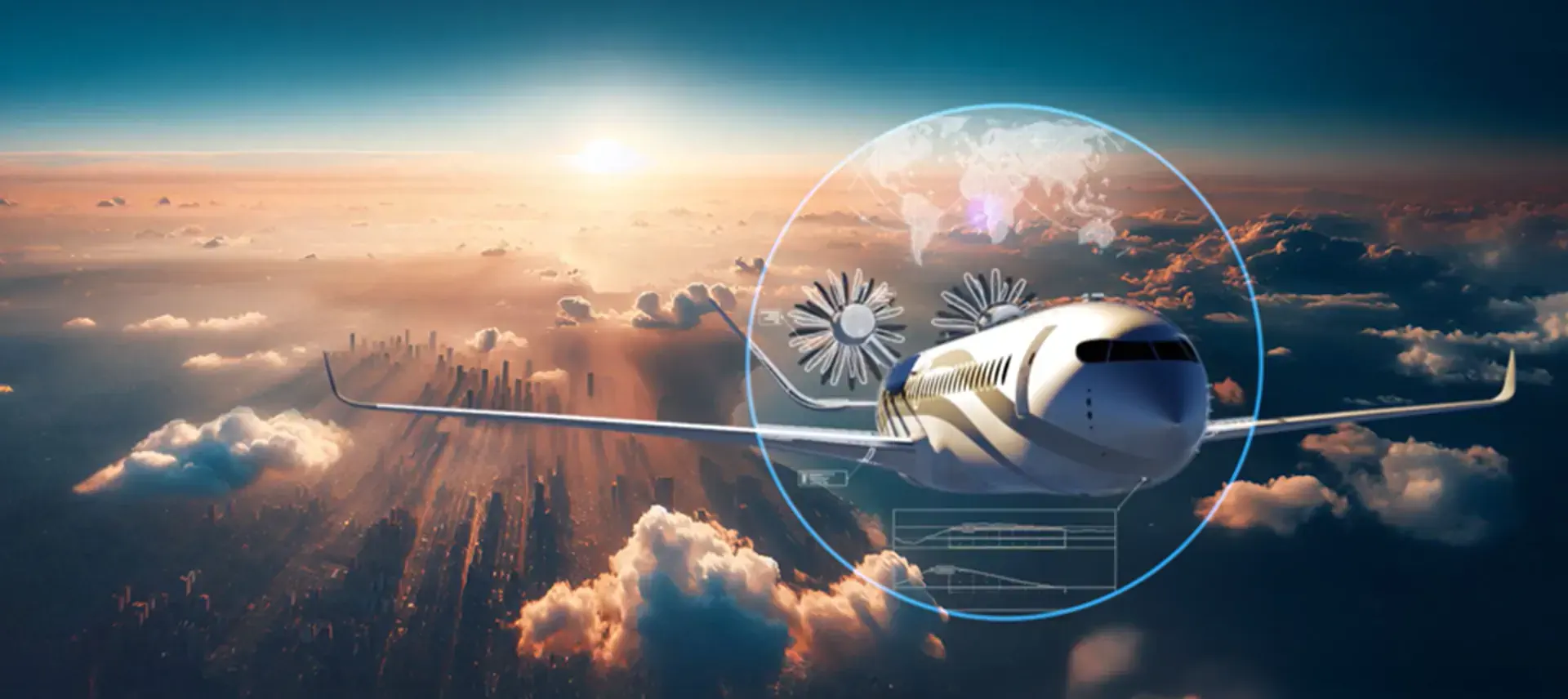Commercial Aviation
Commercial aviation connects people across continents and cultures. At Dassault Systèmes (3DS), we play a crucial role in shaping the industry by leveraging advanced technologies and collaborations across the market.
What Are the Trends Changing the Commercial Aviation Landscape?
Technological and environmental leaps are reshaping the industry. What are they and how will they affect your business?
- Program Innovation
- Advanced Air Mobility
- End to End Quality
- Simulation & Certification
- Smart Sustainment
- Precision Manufacturing
Trends
David Ziegler
Vice President, Aerospace & Defense Industry, Dassault Systèmes
Program Innovation
How would you rethink product development and manufacturing to meet customer and environmental challenges?
The aerospace industry is known for making giant leaps in technology with each generation of aircraft.
The next decade will indeed see more of these great leaps than the past 10 with significant new challenges in sight and new technologies emerging to overcome them. At 3DS, we are at the forefront of this innovation, rethinking product development and manufacturing to meet customer and environmental needs.
Original Equipment Manufacturers (OEMs) must consider how to safely and sustainably move faster through adoption of new technologies such as advanced materials, robotics, additive manufacturing, artificial intelligence, advanced data analytics and other technologies.
These are to be used to achieve greater effectiveness and versatility together with their value network to deliver manned and unmanned systems, greater fuel efficiency in commercial aircraft and increased reliability and cost effectiveness across the board.
We are not just talking about digitalization or a 3D experience; we are rethinking the way aircraft are designed and operated, streamlining and speeding up our processes with customer satisfaction in mind.
Advanced Air Mobility Towards Sustainability
Advanced Air Mobility (AAM) promises to completely change the way we fly by making it faster, safer and more accessible.
Advanced Air Mobility
How do you take on a new market challenge?
Sustainability is redefining aerospace, with strong momentum toward NetZero aircraft. While Sustainable Aviation Fuel serves as a near-term solution, hydrogen and electrification represent the future. With new mobility expected to reach $7.9B by 2030, startups like Joby Aviation, Vertical Aerospace, Beyond Aero are working towards innovation, certification, and delivering sustainable air mobility—without inflating IT costs.
In the highly competitive Advanced Air Mobility (AAM) sector, the first to market will set the benchmark. Success depends on integrated engineering tools that support simulation-driven design, structural optimization, and energy management—ensuring safety through virtual and physical testing.
At Dassault Systèmes, we believe the future of AAM lies in a fully integrated ecosystem: driven by new energy sources, aligned with the global urban mobility shift, and empowered by end-to-end platforms to develop, certify, and launch next-generation sustainable air vehicles.
We’re in the process of writing a new chapter in the aviation industry.
Elevating Quality, Empowering Your Vision
Redefining aerospace and defense: Continuous quality improvement as the enabler for innovation.
End to End Quality
How can you achieve operational excellence with digital continuity?
Quality remains a top priority across the Aerospace & Defense industry, directly impacting KPIs like production rates, cost, and customer satisfaction. Yet, siloed tools and disconnected processes continue to hinder performance.
Dassault Systèmes offers an End-to-End Quality Management approach that integrates quality across engineering, manufacturing, and operations. From Model-Based Program Planning to Advanced Product Quality Planning (APQP), Design and Process Failure Modes and Effects Analysis (DFMEA & PFMEA), and real-time operational feedback, our solution connects every stakeholder in a collaborative, data-driven environment.
By closing the loop between design and execution, organizations can reduce non-conformities, accelerate time-to-market, and continuously improve product and process quality.
Let’s achieve operational excellence through digital continuity, enhanced traceability, and proactive risk mitigation—ensuring quality is no longer a constraint but a competitive advantage.
Our platform shifts organization from firefighting on the shop floor and quality issues to a continuous improvement process.
Get New Aircraft Off the Ground Faster
Connect design and simulation for superior performance without compromise on safety.
Simulation & Certification
How do you accelerate certification without compromising safety?
As aerospace programs evolve toward novel, sustainable aircraft, certification remains a critical—and costly—milestone. Today, most Aerospace & Defense companies use simulation to support design, but siloed teams and fragmented tools limit its full potential.
With the 3DEXPERIENCE platform, Dassault Systèmes enables a unified, model-based approach to simulation and certification. By integrating design and simulation data in one collaborative environment, companies can accelerate design-simulation loops, improve traceability, and drive program maturity. Analysts can perform advanced simulations with built-in version control, knowledge capture, and visualization—enhancing collaboration across teams.
This transformation not only improves product performance but enables Model-Based Certification—a paradigm shift that reduces time, cost, and risk while increasing product safety. The result: faster certification for novel air vehicles, with greater confidence in regulatory compliance and operational readiness.
Being able to manage the entire engineering process with one single source of truth is absolutely key for innovative projects development.
One Platform for Digital MRO
Harness the power of data on a single integrated digital platform to optimize fleet maintenance, repair and overhaul (MRO) in Aerospace & Defense.
Smart Sustainment
How do you reduce maintenance costs while increasing fleet availability?
In today’s aerospace and defense landscape, sustainment is no longer just about maintenance—it’s about mission readiness. Traditional Maintenance Repair and Overhaul (MRO) processes must evolve into smart, data-driven operations to meet increasing demands for availability, efficiency, and cost control.
With Dassault Systèmes’ Virtual Twin Experience, organizations gain a 360° view of fleet operations—bridging engineering, maintenance, and service data into one dynamic environment. This approach accelerates the creation of maintenance documentation directly from engineering sources, reducing both effort and errors.
Smart sustainment empowers teams to optimize planning and execution, proactively address issues, and extend asset life—all while minimizing unplanned downtime and total lifecycle costs.
The result: faster decision-making, lower sustainment costs, and improved mission readiness across the entire fleet.
Regarding legacy and new aircraft fleets, the virtual twin of each aircraft, when connected to real operational data, supports best decisions and maintenance actions to increase aircraft availability and reduce maintenance costs.
Harness Powers of Agility in Production
Your path to the future factory.
Precision Manufacturing
How do you ensure mission-critical quality at scale?
In Aerospace & Defense, precision manufacturing is non-negotiable. Achieving production at rate and quality requires unmatched accuracy, reliability, and performance. From turbine blades to structural airframe components and guidance systems, every part must meet tight tolerances and rigorous safety standards.
To meet these demands, the industry is embracing advanced manufacturing technologies—CNC machining, additive manufacturing, and automated inspection systems—to deliver complex geometries with micron-level precision. Lightweight yet durable materials are also driving innovation in machining and material science.
At Dassault Systèmes, we support this transformation by connecting engineering, manufacturing, and quality teams in a unified digital environment. This integration ensures that design intent is preserved through to production, enabling continuous verification, faster ramp-up, and fewer non-conformities.
The result: higher throughput, reduced scrap, and the confidence to deliver mission-critical systems with precision—every time.
We can create a 3D representation of a production facility, not only adding the parts, the machines and the manpower to account for space, but connecting all of these resources to estimate timings so that we can accurately work out how many components we can deliver in a given time.
Discover more
Build the Future of Sustainable Aviation
Learn how to accelerate sustainable aviation programs from concept to takeoff
More on the Aerospace & Defense Value Chain
Dassault Systèmes has a proven track record as a catalyst and enabler of the world's leading industrial transformations. Discover more here!
More on the Aerospace & Defense Value Chain
Dassault Systèmes has a proven track record as a catalyst and enabler of the world's leading industrial transformations. Discover more here!



